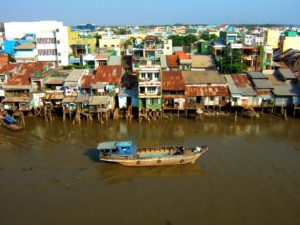
Vietnam is located in the Southeast Asia on eastern edge of peninsula and it is known as Indochina, it is surrounded by china to the north and Laos and Cambodia to west. Mainly the people live in the river delta regions of north and south with green rice fields
IMPORTANT PLACES TO BE VISITED:
- MARBLE MOUNTAIN: South of Da Nang Vietnam are the marble mountains and these are picturesque on their own. Some caves have Confucian or Buddhist shrines, and others were used as sanctuaries and hospitals during the Vietnam War.
- TAM COC:Tam Coc is located in the Ninh Binh province of northern Vietnam and these caves are nestled in a scenic of limestone cliffs and rice paddies and the river winds through the region. The caves are called Hang Ca, Hang Hai, and Hang Ba and also they serve as the areas main attraction with guided boat tours along Ngo Dong River
- HANG SON DOONG CAVE:This cave is the largest cave in the world and which is about three million years old with incredible destination spot. The cave is amazed with bright blue water pools and inside river runs through it and greenery lines the walls
- CAO DAI TEMPLE:Cao Dai temple is the most sacred attraction’s in Vietnam which was constructed in 1930.In the main building of the Cao Dai Temple, there are four prayers conducted daily, and visitors can watch or even participate in the ceremonies
FEATURES OF VIETNAM:
- Vietnam is a thin country and it is located in the Southeast Asia which borders by neighbour countries like China to north, Laos and Cambodia to west
- Hanoi is the capital of the country and also known as the Ho Chi Minh which is the largest city and the official name is Socialist Republic of Vietnam
- Majority of population of Vietnam where Vietnamese covering nearly eighty six percent and the government followed is Marxist Lininist with President and Prime Minister
- The country’s culture is divided into three categories namely north, centre and south which serves the main cities and Hanoi city located in the south portion has been the earliest dynasties
- By the influence of French colonialism there arises a modern Vietnamese
- There are about three to five ethnic groups in Vietnam and the majority groups inhabits in the highland area and the small groups are inhabited in the lowland areas
- Vietnamese is the both official and national language and it has six different tones with change in tone changes the entire meaning of it, the other languages include Chinese, Cham which are widely spoken by the tribes of mountainous region
- The national flag of Vietnam is of with red field background in the centre with a large yellow colour star
- Hinduism is the traditional religion of Vietnam and the remaining Chinese religions followed are Buddhism, Daoism and Confucianism
- Until 13th century the language of Vietnam was written in Chinese character and later they developed their own words